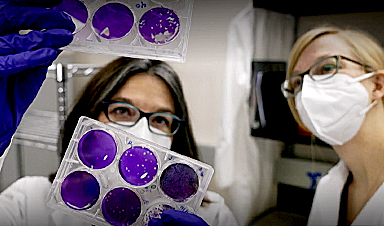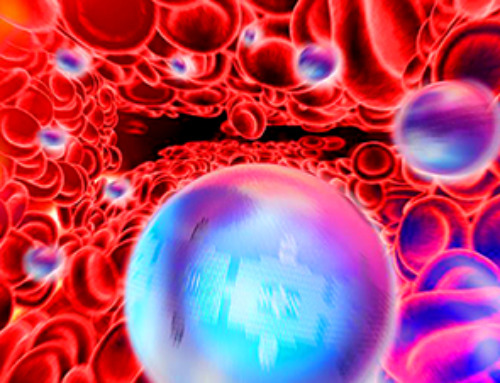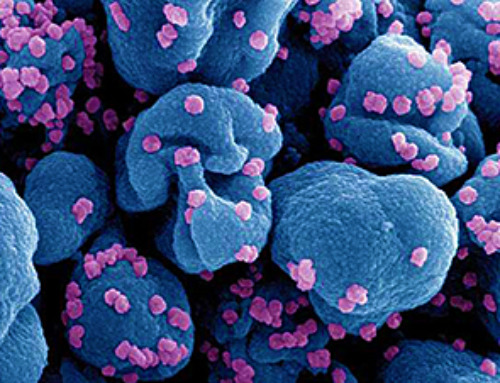Early on in the pandemic, in 2021, Hugh Potter ate dinner and watched TV next to his wife while she coughed violently from COVID-19, yet he never even sniffled.
It’s been thought that some people may not have gotten COVID because they were careful to avoid exposure. Alternatively, some people may have been infected but showed no symptoms. Another possibility is that some people have a genetic advantage that makes them a super-dodger.
“Bloody lucky,” Potter, 68, said. “Where I work, I think almost everyone has had it.” A few didn’t believe the Pickering, Ont., resident has escaped it since the early years of the pandemic.
Now, experts peering into the genes of such rare people have gained some surprising insights.
COVID-19 has infected hundreds of millions worldwide, yet some never get it. British researchers now think the reason could be a specific gene that gives the immune system advance warning to destroy viral invaders quickly.
Last week, scientists writing in the journal Nature described high activity of a specific gene in people who didn’t get infected. And in a complementary research project, Potter provided DNA from saliva samples to researchers at McGill University Health Centre looking for those with a golden armour against the virus.
Researchers hope by better understanding early immune responses, it could help with developing nasal spray forms of vaccines for the coronavirus, similar to the existing FluMist to prevent influenza.
As much as people may wish to forget the pandemic emergency, the virus is still with us and kills about 20 people a week in Canada. The World Health Organization reported more than 2,600 new fatalities in April, bringing total confirmed cases to over 775 million including more than seven million deaths globally.
Voluntary infection
To gain some leads into what makes people super-dodgers, in March 2021, investigators with the UK COVID-19 Human Challenge study administered a low dose of the original form of SARS-CoV-2 through the nose to 36 healthy adult volunteers and then closely tracked how long it took their immune cells to kick into gear. None were previously exposed to the virus or vaccinated.
The 16 participants with detailed monitoring of their blood and nose fell into three groups:
- Six developed a sustained infection and fell ill.
- Three became infected but quickly cleared the virus.
- Seven never tested positive on the gold standard PCR test, which shows they successfully prevented infection.
Christopher Chiu, a professor of infectious diseases at Imperial College London, and his co-authors saw high levels of activity in a gene called HLA-DQA2. They think the gene helps flag invaders to the immune system so it can quickly destroy the virus.

For medical researchers, the study offers a step-by-step look at what happens in the immune responses to the virus in both the nose and blood and their interaction.
Location, location, location
Immunologists who weren’t involved in the U.K. study say they’re not sure why or how that specific gene offers protection.
“If you had asked me to bet money on the genes involved in the protection, they’re not the ones I would have chosen,” said professor Dawn Bowdish, who holds the Canada Research Chair in Aging and Immunity at McMaster University in Hamilton.
The realtor’s motto of location, location, location applies, Bowdish said, because our nose, blood and lungs all differ in the type and timing of immune responses.
For instance, the vaccines we get in the arm are designed to trigger our immune system to mount a response as part of adaptive immunity.
HLA genes take up the trigger and present it to fighter cells of the immune system.
While the particular HLA in the study was better at blocking infection in COVID, it isn’t necessarily better overall since it is also associated with some diseases like lupus and rheumatoid arthritis, said Dr. Lynora Saxinger, an infectious diseases specialist at the University of Alberta.
In people who got a sustained infection in the study, it took their immune systems a while to concentrate efforts in the nasal mucosa lining areas like the nose, Saxinger said. In contrast, findings from those who mounted the fastest immune response could invigorate the field of nasal vaccines.
Blocking infection
Teams of researchers at McMaster and the University of Ottawa are among those aiming to design nasal spray or puffer forms of inhaled vaccines to not only prevent the risk of severe illness requiring hospitalization and death from COVID — as current vaccines do — but to block infection altogether.
Bowdish said scientists used to think turning on immune cells in the nose would be enough to kill the virus. But in the new study from England, cells involved in recruiting immune reactions in the mouth, nose and lungs were all important.
“We are hoping to move to a world where we use inhaled vaccines or nasal vaccines, and this gives us some hints about what specific … immune genes we want those vaccines to turn on to help protect us,” Bowdish said.
It’s been four years since COVID-19 was declared a pandemic, and new research suggests your age may determine how often you should get a booster shot.
Saxinger called the opportunity to block infection “really big,” adding understanding how to clear the virus early is also important to prevent asymptomatic spread.
The pandemic landscape of variants and immunity from vaccinations is now very different than when the volunteers were exposed in the study. Some people come down with COVID repeatedly as variants evolve to dodge immune defences. And COVID illness continues to push some older, vulnerable individuals over the edge when hospitalized, doctors say.
Next, the British researchers plan to test the potential of several nasal spray vaccines against the family of coronaviruses that includes SARS-CoV-2, MERS and four seasonal common cold viruses in other human challenge trials.
“There might be some kind of common features that that would allow you to consider preventative or very early treatment,” Saxinger said.
News
What could the future of nanoscience look like?
Society has a lot to thank for nanoscience. From improved health monitoring to reducing the size of electronics, scientists’ ability to delve deeper and better understand chemistry at the nanoscale has opened up numerous [...]
Scientists Melt Cancer’s Hidden “Power Hubs” and Stop Tumor Growth
Researchers discovered that in a rare kidney cancer, RNA builds droplet-like hubs that act as growth control centers inside tumor cells. By engineering a molecular switch to dissolve these hubs, they were able to halt cancer [...]
Platelet-inspired nanoparticles could improve treatment of inflammatory diseases
Scientists have developed platelet-inspired nanoparticles that deliver anti-inflammatory drugs directly to brain-computer interface implants, doubling their effectiveness. Scientists have found a way to improve the performance of brain-computer interface (BCI) electrodes by delivering anti-inflammatory drugs directly [...]
After 150 years, a new chapter in cancer therapy is finally beginning
For decades, researchers have been looking for ways to destroy cancer cells in a targeted manner without further weakening the body. But for many patients whose immune system is severely impaired by chemotherapy or radiation, [...]
Older chemical libraries show promise for fighting resistant strains of COVID-19 virus
SARS‑CoV‑2, the virus that causes COVID-19, continues to mutate, with some newer strains becoming less responsive to current antiviral treatments like Paxlovid. Now, University of California San Diego scientists and an international team of [...]
Lower doses of immunotherapy for skin cancer give better results, study suggests
According to a new study, lower doses of approved immunotherapy for malignant melanoma can give better results against tumors, while reducing side effects. This is reported by researchers at Karolinska Institutet in the Journal of the National [...]
Researchers highlight five pathways through which microplastics can harm the brain
Microplastics could be fueling neurodegenerative diseases like Alzheimer's and Parkinson's, with a new study highlighting five ways microplastics can trigger inflammation and damage in the brain. More than 57 million people live with dementia, [...]
Tiny Metal Nanodots Obliterate Cancer Cells While Largely Sparing Healthy Tissue
Scientists have developed tiny metal-oxide particles that push cancer cells past their stress limits while sparing healthy tissue. An international team led by RMIT University has developed tiny particles called nanodots, crafted from a metallic compound, [...]
Gold Nanoclusters Could Supercharge Quantum Computers
Researchers found that gold “super atoms” can behave like the atoms in top-tier quantum systems—only far easier to scale. These tiny clusters can be customized at the molecular level, offering a powerful, tunable foundation [...]
A single shot of HPV vaccine may be enough to fight cervical cancer, study finds
WASHINGTON -- A single HPV vaccination appears just as effective as two doses at preventing the viral infection that causes cervical cancer, researchers reported Wednesday. HPV, or human papillomavirus, is very common and spread [...]
New technique overcomes technological barrier in 3D brain imaging
Scientists at the Swiss Light Source SLS have succeeded in mapping a piece of brain tissue in 3D at unprecedented resolution using X-rays, non-destructively. The breakthrough overcomes a long-standing technological barrier that had limited [...]
Scientists Uncover Hidden Blood Pattern in Long COVID
Researchers found persistent microclot and NET structures in Long COVID blood that may explain long-lasting symptoms. Researchers examining Long COVID have identified a structural connection between circulating microclots and neutrophil extracellular traps (NETs). The [...]
This Cellular Trick Helps Cancer Spread, but Could Also Stop It
Groups of normal cbiells can sense far into their surroundings, helping explain cancer cell migration. Understanding this ability could lead to new ways to limit tumor spread. The tale of the princess and the [...]
New mRNA therapy targets drug-resistant pneumonia
Bacteria that multiply on surfaces are a major headache in health care when they gain a foothold on, for example, implants or in catheters. Researchers at Chalmers University of Technology in Sweden have found [...]
Current Heart Health Guidelines Are Failing To Catch a Deadly Genetic Killer
New research reveals that standard screening misses most people with a common inherited cholesterol disorder. A Mayo Clinic study reports that current genetic screening guidelines overlook most people who have familial hypercholesterolemia, an inherited disorder that [...]
Scientists Identify the Evolutionary “Purpose” of Consciousness
Summary: Researchers at Ruhr University Bochum explore why consciousness evolved and why different species developed it in distinct ways. By comparing humans with birds, they show that complex awareness may arise through different neural architectures yet [...]





















